The Economics and Statistics Division maintains archives of previous publications for accountability purposes, but makes no updates to keep these documents current with the latest data revisions from Statistics Canada. As a result, information in older documents may not be accurate. Please exercise caution when referring to older documents. For the latest information and historical data, please contact the individual listed to the right.
<--- Return to Archive
For additional information relating to this article, please contact:
April 29, 2021EMPLOYMENT, EARNINGS AND HOURS, FEBRUARY 2021 PAYROLL EMPLOYMENT
Nova Scotia had 411,911 payroll employees in February 2021, edged down 0.04% (-185) compared to January 2021, and down 2.8% (-11,729) compared to last February. Nova Scotia's payroll employment had been trending upwards since 2017 but declined sharply after February due to restrictions and closures resulting from COVID-19 and partially rebounded from June to November due to eased restrictions. In December 2020, Nova Scotia's payroll employment edged down on renewed COVID-19 restrictions in November 2020. Nova Scotia's payroll employment showed recovery in January 2021.
Canada had 15.9 million employees, an increase of 0.3% (+43,385) compared to last month and down 6.8% (-1,157,348) compared to a year ago.
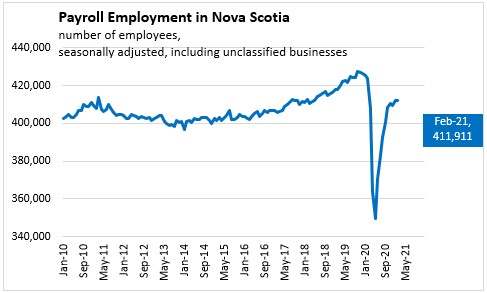
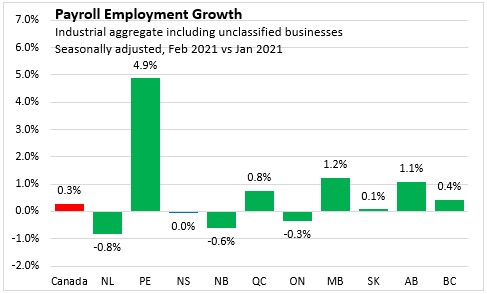
Compared to February 2020, Nova Scotia's payroll employment is down 2.8% in February 2021. Nationally, payroll employment is down 6.8% in February 2021, with all provinces reporting decreases except Prince Edward Island (+3.1%). The largest payroll employment decline has been observed in Alberta (-8.5%) and Ontario (-8.4%). The smallest decline has been observed in New Brunswick (-0.7%).
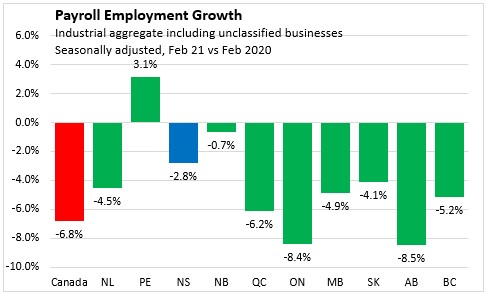
In Jan-Feb 2021, Nova Scotia's payroll employment declined 2.9% over Jan-Feb 2020. Nationally, payroll employment declined 7.0% in Jan-Feb 2021, with all provinces reporting decreases except Prince Edward Island (+0.5%). The largest payroll employment decline has been observed in Alberta (-9.3%) and Ontario (-8.3%). The smallest decline has been observed in New Brunswick (-0.5%).

In January-February 2021, payroll employment was down 1.7% in Nova Scotia's goods producing sectors compared to January-February 2020. Goods sector payroll employment was down for manufacturing (-1.1%), construction (-2.1%) and forestry/logging (-4.5%) sectors compared to January-February 2020.
Service sector employment was down 3.1% in January-February 2021 compared to January-February 2020. Service sector payroll employment decreased the most in percentage terms in accommodation and food services (-19.6%), arts/entertainment/recreation (-15.0%), and real estate/rental & leasing (-10.1%). Payroll employment increased in finance and insurance (+1.8%), professional/scientific/technical services (+2.5%), management of companies (+22.5%) and education (+2.1%).
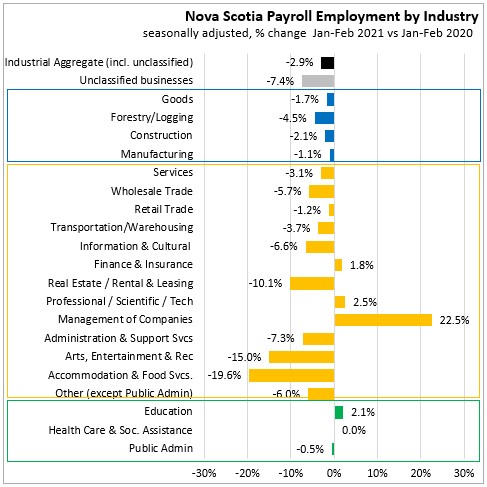
AVERAGE WEEKLY EARNINGS
Changes in average weekly earnings reflect wage growth as well as changes in the composition of employment by industry/occupation/experience, and average hours worked per week. During COVID-19, large employment losses have been reported in industries with relatively low average weekly earnings. This means that average weekly earnings were increasing because those remaining employed are working in industries with higher average weekly earnings.
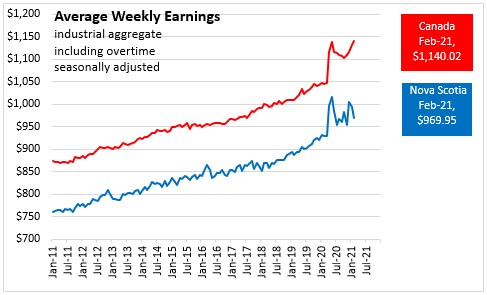
Nova Scotians' average weekly earnings (including overtime, seasonally adjusted) decreased 2.4% (-$23.82) from January 2021 to $969.95 in February 2021. Average weekly wages were up 4.4% compared with February 2020. Canadians' average weekly wages increased 0.7% month to month ($1,140.02 in February 2021) and were 9.0% higher than they were a year ago.
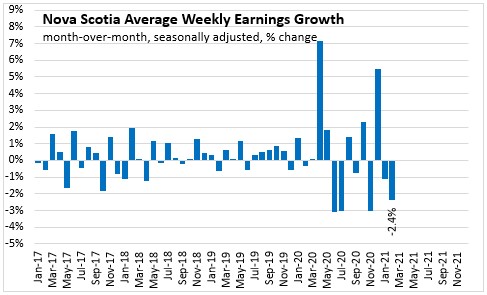
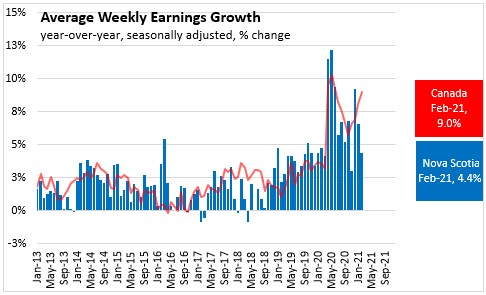
Across the country, there were monthly increases in five provinces, with the largest increase in Ontario (+1.1%) and Manitoba (+0.8%). The largest decreases were reported in Prince Edward Island (-2.6%) and Nova Scotia (-2.4%).
Compared to a year ago, average wages were higher in all provinces, with the largest increases in percentage terms reported in Ontario (+11.7%), British Columbia (+9.1%) and Quebec (+8.8%). The slowest growth in average weekly earnings was observed in Newfoundland and Labrador (+2.3%).
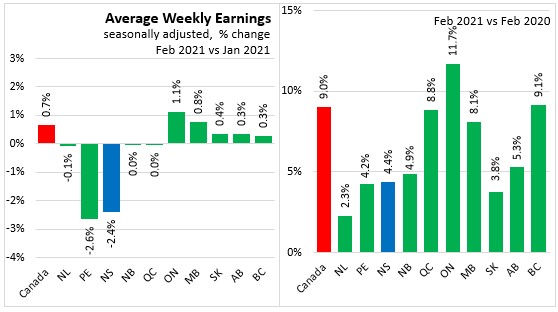
Compared to January-February 2020, Nova Scotia's average wages were up 5.5% in January-February 2021. Nationally, average wages were up 8.6% in January-February 2021 over January-February 2020. Average wages were higher in all provinces, with the largest increases in percentage terms reported in Ontario (+11.1%) and British Columbia (+8.9%). The slowest growth in average weekly earnings was observed in Newfoundland and Labrador (+1.9%).
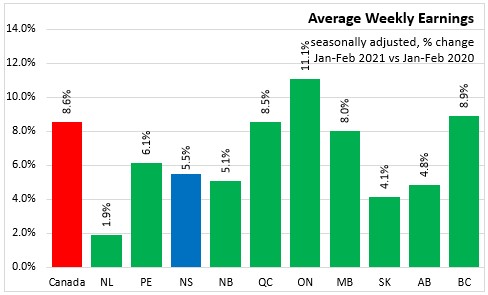
In January-February 2021, average weekly earnings were up 3.6% in Nova Scotia's goods producing sectors over January-February 2020. Goods sector wages were up for construction and manufacturing sectors. Service sector average earnings were up 5.7% in January-February 2021. Service sector earnings increased the most in percentage terms in finance and insurance (+16.5%) and transportation/warehousing (+15.5%). Service sector earnings decreased the most in health care and social assistance (-1.7%).

REFERENCE TABLES - (January-February 2021 vs January-February 2020)
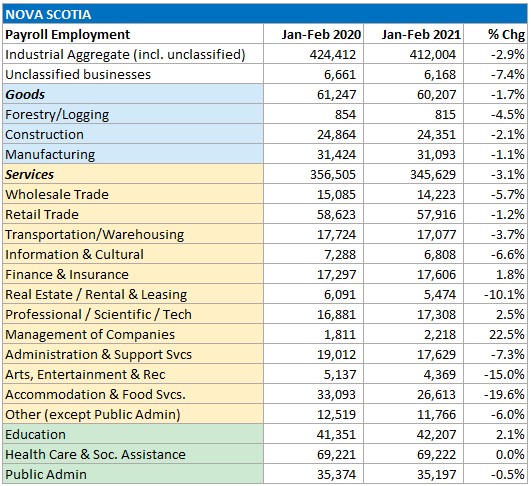
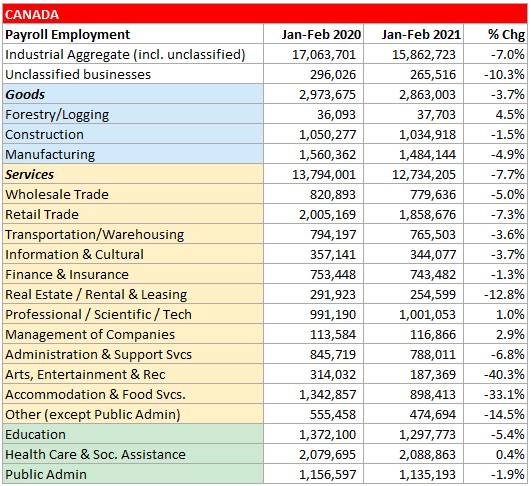
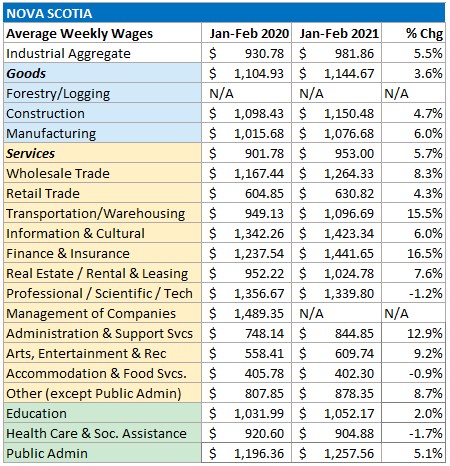

Source: Statistics Canada. Table 14-10-0222-01 Employment, average hourly and weekly earnings (including overtime), and average weekly hours for the industrial aggregate excluding unclassified businesses, monthly, seasonally adjusted; Table 14-10-0223-01 Employment and average weekly earnings (including overtime) for all employees by province and territory, monthly, seasonally adjusted
<--- Return to Archive